Cat S60 — More than the naked eye can see
They used to say, and likely still do, that a picture is worth a thousand words. That’s certainly true, but it can also be quite misleading as pictures often tell a story rather than the story. There can be quite a difference between these two. The media is very adept at using carefully chosen pictures that tell a story that may or may not be so, or present the story with a slant or an agenda. One could almost say that a picture can tell a story in a thousand different ways. And in the age of Photoshop (generically used here; any image program can do), that’s more true than ever. And let’s not even talk about videos.
There is, however, another aspect of pictures. Most only tell what the human eye can see. Light is electromagnetic radiation, and only a small part of it is visible to the human eye as colors. It’s the part with wavelengths of roughly 380 to 750 nanometers. Below that is ultra-violet and then x-rays and other rays. Above that first infrared, then microwaves and radio waves.
I’ve always been interested in the spectrum beyond what we can see.
My initial degree was in architecture, and that meant understanding the principles of heating and cooling as well as energy conservation. While we humans primarily feel temperature, temperature can also be seen. Technologies that make infrared wavelengths visible to the human eye can show us temperatures as colors.
As an enthusiastic scuba diver I learned the ways light behaves underwater. Colors are different underwater because waves travel differently, and some wavelengths are filtered out by water sooner than others. Lower energy waves are absorbed first, so red disappears when a diver reaches a depth of about 20 feet. Orange disappears next, at around 50 feet. Then yellow at about 100. Green stays longer and blue the longest, which is why things look bluer the deeper you go. But it’s not always like that. For example, I found that sometimes I could see red at depths where it was not supposed to be visible. I wrote about that in Red at Depth.
The image below shows the same coral head at a depth of about 90 feet without artificial light on the left, and with the flash on the right. Without the flash, the red on the left ought not to be visible at all. And yet it is.
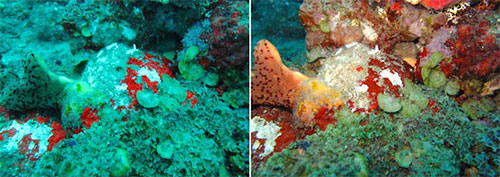
Then there’s the interesting phenomenon of fluorescence. Fluorescence essentially describes the physical process of a substance absorbing light at the incoming wavelength, and re-emitting it at a different wavelength. Almost everyone has seen the ghostly effects of “black light” that makes some materials glow brightly while leaving others unaffected. Through scuba I found that there’s a totally fascinating world of fluorescence under the sea. I described that in Night Dives Like you’ve Never Experienced Before.
The image below shows an anemone we photographed with a yellow filter and a NightSea fluorescent protein flashlight. In normal light you’d barely see the animal, but it is strongly fluorescent and lights up under certain incoming wavelengths.
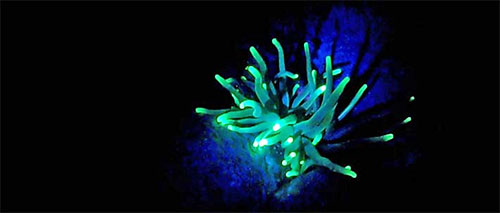
Having founded Digital Camera Magazine in 1998 gave me an opportunity to witness the progression of digital imaging and also the opportunity of hands-on with a large number of different cameras and lenses. That knowledge and experience not only in cameras but also the underlying imaging technologies led to an interest in emerging uses and applications. That included explorations in ultra-slow motion imaging for science projects with my son, and examining the emerging action photography and videography market (it’s safe to say that I helped GoPro understand how light behaves underwater; see The GoPro phenomenon: what the world-beating little 1080p vidcam can (and cannot) do).
Below you can see me testing different color filters in a Northern Florida spring with a specially built rig with two GoPro Hero 3 cameras.
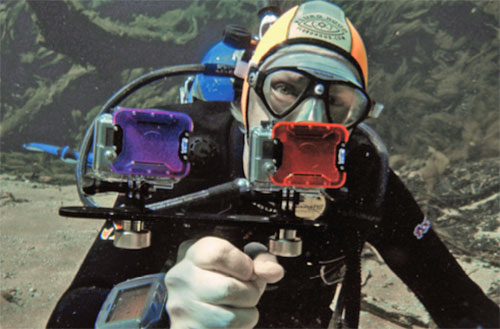
In my work as publisher of RuggedPCReview and before that Editor-in-Chief of Pen Computing Magazine, I came to appreciate thermal modeling and design in microelectronics where proper cooling and removal of heat generated by the processor and related circuitry is among the most important aspects of any mobile computing design.
That’s where infrared imaging comes into play. Human eyes and normal cameras cannot see infrared. Older generations will remember that infrared, commonly referred to as IR, was widely used for data communication between computers and devices, and it is still used in many remote controls. Older audiences will also remember the “Predator” movies where those merry human-hunting aliens saw the world in infrared. Infrared, or thermographic, cameras have been available for decades, but at a high price.
Recently, a company named FLIR Systems changed all that with a series of much lower priced thermographic cameras as well as the FLIR One thermal imaging camera module that snaps onto an iPhone or Android device. Not having a review relationship with FLIR, I pre-ordered FLIR One for my iPhone 6 Plus, and it arrived late 2015.
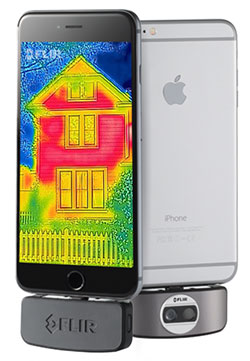 The FLIR One is an absolutely revolutionary product in that it lowers the cost of very functional thermal imaging to around US$250. The way the FLIR One works is that it shoots both a thermal image and a conventional picture. Why the conventional picture? Because thermal imagery doesn’t provide much physical detail and it can be difficult for our eyes, unaccustomed to thermal data, to interpret the image. So what the FLIR One does is extract line-drawing type of detail from the conventional image and then merges it with the thermal image. That makes it much easier to exactly see what the thermal data pertains to. The FLIR One does all of that automatically.
The FLIR One is an absolutely revolutionary product in that it lowers the cost of very functional thermal imaging to around US$250. The way the FLIR One works is that it shoots both a thermal image and a conventional picture. Why the conventional picture? Because thermal imagery doesn’t provide much physical detail and it can be difficult for our eyes, unaccustomed to thermal data, to interpret the image. So what the FLIR One does is extract line-drawing type of detail from the conventional image and then merges it with the thermal image. That makes it much easier to exactly see what the thermal data pertains to. The FLIR One does all of that automatically.
When you show an IR picture to an uninitiated person, they will almost always assume it’s just a Photoshop filter applied to a regular picture. But that’s definitely not so. The thermal camera records data readings and then displays those on a color scale. FLIR One users can select from various color schemes. Since most people associate blue with cold and red with hot, I usually use the blue-red scheme.
What can you use the FLIR One for? Well, the applications are almost endless. The architect in me began a thermal imaging review of my home, identifying the efficiency of insulation and the presence of leaks. The scuba diver in me donned full scuba gear and examined hot and cold spots as those can definitely be an issue on a deep cold-water dive. And the reviewer of advanced rugged mobile computing products in me, of course, instantly began examining the thermal properties of gear in our RuggedPCReview testing lab. It’s fascinating to see the heat signature of a mobile computing device, how it changes as the device heats up, and get an overall idea of how well the designers and engineers handled the thermal aspects of their products.
Below are some example of images taken with the FLIR One iPhone module. The image on the left shows a heater floating in an iced-over Koi pond. Dark blue is the ice on the surface of the pond, orange and yellow the warmer water kept ice-free by the heater. The image on the right shows the thermal design of a RuggON PX-501 tablet (see our full review). Yellow shows the heat-generating CPU and ancillary circuitry, as well as the copper heat conduit to the fan.
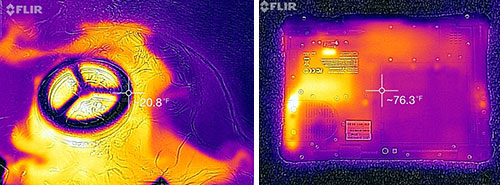
The two pictures below help architects, home owners and contractors. On the left, it’s obvious which part of an attic room needs better insulation. On the right, you can literally see the cold air wafting in between two windows on an icy December day.

Is the FLIR One perfect? Not yet. While quadrupling thermal resolution over earlier low-cost efforts, it’s still only 160 x 120, far, far less than the typical 8-16 megapixel recorded of the visible light spectrum. You don’t need nearly as much resolution to convey useful thermal imagery (640 x 480 is considered high-res) and so the current low res is not a big problem. And now that FLIR has gained a foothold with the FLIR One and similar offerings, we’ll likely see higher resolutions very soon.
But my story doesn’t end here. In fact, you could say everything above is just an introduction to the news I had wanted to write about, the Cat S60.
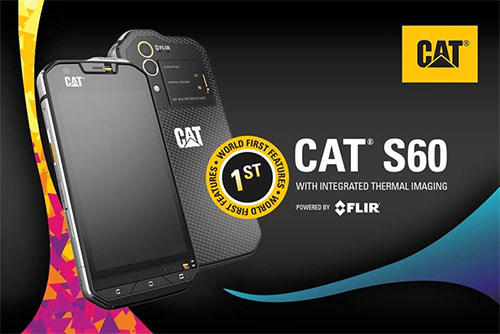
Normally, we consider ourselves pretty well informed about anything in the rugged computing industry, but the Cat S60, officially introduced February 18, caught us by surprise. What is the Cat S60? Cat? Yes, Cat as in Caterpillar! Caterpillar actually sells a line of rugged smartphones on catphones.com. They all look suitably rugged, they all sport the familiar Cat logo, and their design language is reminiscent of Caterpillar’s earthmoving machinery.
What immediately came to mind were branded signature edition of rugged hardware, like the “Hummer” version of one of the rugged Itronix notebooks several years ago. So did Caterpillar actually also make smartphones? Not really. Turns out that the Caterpillar phones come courtesy of UK-based Bullitt Group, a privately held technology company that apparently works with a number of tech companies. From what I can tell they either license famous brand names or work in joint ventures. As a result there are JCB phones (JCB is a British heavy equipment manufacturer), Kodak Phones, and Bullitt has even licensed the Marconi brand from Ericsson to launch a range of radios named after the very inventor of radio. Bullitt does about $100 million in sales a year, not tremendous, but very respectable.
What’s really interesting, though, is that the Cat S60 is not just a rugged smartphone built to benefit from the Caterpillar image and name. No, it’s actually what Bullitt calls “the world’s first thermal imaging smartphone” and it has a built-in FLIR imaging camera. So you get thermal imaging built right into your rugged smartphone. The Snapdragon 617 octa-core powered Android Marshmallow phone itself has a bright 540 nits 4.7-inch procap display that can handle wetness and gloves. Ruggedness specs are quite impressive with a 6-foot drop, and what appears to be IP68 sealing. The Cat S60 is said to be waterproof down to 17 feet for an hour, and its 13mp documentation camera can supposedly be used underwater (see Catphones media release).
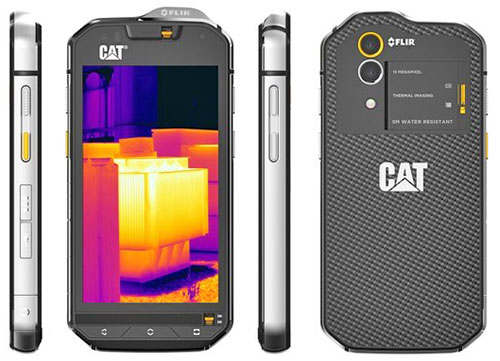
Wow. That is impressive indeed. Having a rugged smartphone with integrated thermal imaging capability opens up entirely new applications and functionality in any number of areas. How is this possible? With FLIR’s tiny Lepton longwave infrared sensor that’s smaller than a dime. For those interested in all the detail, here’s the full FLIR Lepton datasheet in PDF format. Resolution of the initial Lepton imager is limited to 80 x 60 pixel, the same as in FLIR’s iPhone 5 camera module, and entirely adequate for thermal imaging on a small smartphone screen. How much does the CAT S60 cost? US$599. Which seems almost too good to be true.
This is all very exciting. I don’t know what Caterpillar’s reach is in phones, given that we had actually never heard of their phone operation. Then again, I yesterday had a meeting with my landscape architect, and the man had not only heard of, but was very interested in the new Cat S60. I can absolutely see how offering rugged handhelds or tablets with an integrated FLIR Lepton camera can be a strategic advantage, especially if bundled with thermal imaging demos and apps. And having that kind of functionality in a product would not only be of great interest to many customers, but also definitely gold for marketing.